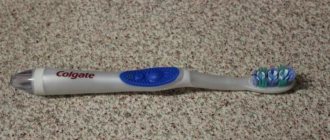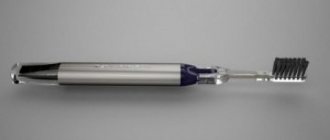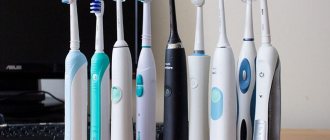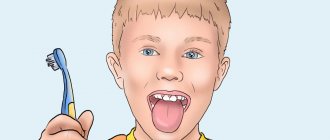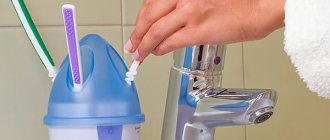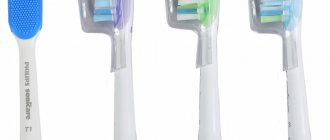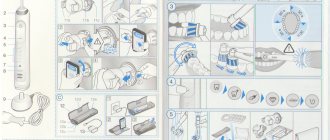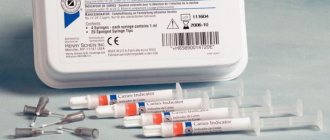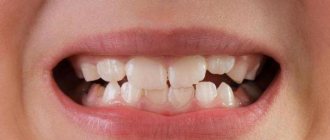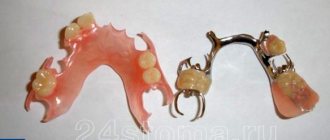Many people buy toothbrushes without thinking about their technical characteristics and based only on price. However, they differ in many parameters: the material and stiffness of the bristles, the shape and size of the head, etc. To choose the right toothbrush, you should take into account as many criteria as possible. Let's tell you more about them.
In this article
- Which toothbrush to choose
- What shape and size should a toothbrush be?
- How to choose a toothbrush based on bristle material
- What toothbrush is best?
- Which toothbrush to choose - soft or hard?
- How to choose a brush based on the shape of the bristles
- Additional functions of toothbrushes
- Hardness of electric toothbrushes
- Which toothbrush to buy
- How often to change the brush
- How to care for your brush
When buying a toothbrush, do we think about the stiffness of the bristles, the size of the head, the material and its other parameters? As a rule, we choose them based on external data, based on the fact that one model is suitable for adults, the other for children. However, the quality of cleaning the oral cavity depends on a properly selected toothbrush. If it is not suitable for medical parameters and individual anatomical features, it cannot be used, as there is a risk of damage to the gums and enamel. In addition, brushing your teeth with such a brush will simply be inconvenient.
Understanding this issue is not so difficult. There are several criteria that will help you choose the right toothbrush.
What shape and size should a toothbrush be?
Toothbrushes are available in different sizes and head shapes. Please note the following features:
- The head should cover a maximum of 2-2.5 teeth. Only in this case will cleaning be effective. The head is too large and does not allow the bristles to penetrate into the interdental spaces.
- The length of the toothbrush head for children should be 18-25 mm, and for adults - 30 mm maximum. The child’s teeth are just growing, the jaw is not yet formed, so the large head can injure the gums. Small brushes are not useless for an adult, but brushing teeth with them is inconvenient. In addition, you will have to spend a lot of time on the procedure.
- The head should have a rounded shape to minimize the risk of injury to the oral mucosa.
- The area connecting the head with the handle must be movable so that the spring effect is triggered, due to which the pressure on the teeth and gums is reduced. Almost all modern brushes have a flexible neck to control pressure.
Brushes differ in the number of tufts. The larger the head, the more bristles it is equipped with. Children under 6 years old need to choose models with 23 bundles, teenagers - with 30-40, adults - with 45-55 bundles. People with braces should have a multi-tuft brush (more than 55). Their number is indicated on the packaging. It is not always possible to quickly find this parameter among the information written in small print. However, the quality of teeth cleaning depends on this, so it is better not to ignore this feature of the brush.
As for the handle, it just needs to be comfortable. It is advisable to choose a model with a rubberized coating that will not slip out of your hand.
Choosing a toothbrush for a child
Particular attention in this matter should be paid when selecting a device for children under three years of age. Due to careless use, a child very often causes damage to the gums with a toothbrush, after which an inflammatory process may occur. Therefore, you need to select it based on simple recommendations.
Firstly, the bristles must be soft, the length of the working head should not exceed more than 2 cm. From the age of three, it is allowed to use electrical appliances or manual brushes with a long head of 2.5 cm. They are used up to 7 years. Starting from school age, the length of the working surface of the device should be 3 cm.
Toothbrush for gums under the brand ROCS
Table. Toothbrushes for gum care for children:
| No. P/P | Name | Device Features | Recommended age of use |
| 1. | Silver Care. | Has an additional 999 sterling silver plating. Thanks to this, additional antiseptic treatment of the oral cavity is carried out. Wave-shaped bristles allow you to thoroughly clean all surfaces of tooth crowns. The flexible handle ensures pressure is distributed on the teeth and gums with optimal force. Despite its uniqueness, the price of the device is relatively low. | From 2 years of age and older, pregnant women, patients with diabetes, adolescents in adolescence when sensitivity to irritants appears and during the period of change in bite. |
| 2. | Pigeon. | It massages the gums perfectly and is small in size for ease of use. This is also facilitated by a special fixing ring. Thanks to the special placement of the bristles, the massage effect is carried out on both sides of the alveolar process. This toothbrush is for baby's sensitive gums, which will provide the necessary care and massage to problem areas. | From 6-8 months. |
| 3. | Rox. | Thanks to the special design, the child really likes it. Soft bristles will not allow you to injure the tissues of the oral cavity, no matter how hard the baby tries. However, the brush requires replacement after a month of use. | The device can be used to care for the gums of a child from 0 to 3 years old. |
| 4. | Oral-b stage 1. | It features comfortable and soft bristles, and there is absolutely no risk of allergic reactions. | From 0 to 3 years. |
| 5. | Philips. | The electric device is ideal for daily care of teeth and gums. | From 3 years old. |
| 6. | Braun Oral-B Kids Power | A toothbrush specially designed for children, taking into account the age-related characteristics of the structure of the dental system. | From 3 years old. |
| 7. | Chicco. | Has a soft and gentle cleansing effect. The handle has a comfortable anatomical shape with a rubber coating for better fixation in the baby's hand. The massage effect of the periodontium is provided by rounded bristles. | From 6 months. |
| 8. | NUBY. | This product is a massager brush. Used by parents from an early age of the child. Made from the softest silicone. It has good cleaning properties of periodontal and milk teeth. | From 0 to 1 year. |
| 9. | Clear Clean. | A special feature of the device is the presence of a special partition, which ensures safe cleansing of even the most delicate gums. | From 0 to 2 years. |
Finger-shaped toothbrush for little ones
How to choose a toothbrush based on bristle material
Today, products made from natural materials are popular. Some people also prefer to buy toothbrushes with natural bristles, such as pig bristles.
However, dentists claim that it is better to abandon this idea for the following reasons:
- In bristles made from natural material, microorganisms multiply twice as fast. You will have to change such a brush more often - almost every month.
- The tips of pig bristles cannot be made rounded, so they can be traumatic. These brushes are not suitable for those with sensitive gums. It is also better not to buy them for children.
- Natural bristles quickly become shaggy: the hairs soften, flake and spread to the sides. The brush loses its shape and functionality. You won't be able to brush your teeth properly with it. In addition, the soft tissue of the oral cavity can be damaged by the plastic head.
Dentists advise choosing toothbrushes with nylon bristles and a safe plastic handle. It is safe for teeth, suitable for almost everyone and easier to dispose of without harming the environment. Now we’ll find out which toothbrush hardness is best to choose.
What is a toothbrush for sensitive gums?
Reference! For sensitive gums, manufacturers create toothbrushes with a special type of bristles. They are usually labeled on the packaging as ultra-soft or sensitive.
The devices that can be used for such problems have fibers with rounded ends glued in.
During cleaning, they remove “fresh” plaque well, are gentle on the oral cavity without damaging sensitive tissue, and do not cause pain.
cleaning products are mostly synthetic.
After all, natural pile has a core that accumulates bacteria and promotes their proliferation.
If you have gum disease, additional bacteria will only make the disease worse.
Note! The handles of such devices are made flexible and springy so that a person cannot damage the delicate tissues of the oral cavity by applying excessive pressure on the brush.
This does not apply to electrical devices; they simply use a special head to solve the sensitivity problem.
For cleaning personal hygiene items, you need to buy the appropriate toothpaste for sensitive teeth, otherwise it will not be able to fully protect the tissues from inflammation.
Products with hard bristles wear away enamel and accelerate dentin exposure.
Therefore, they are prohibited for people with increased sensitivity of the oral cavity.
What toothbrush is best?
Toothbrushes are divided into the following types according to the stiffness of the bristles:
- Very soft. An excellent option for those with bleeding gums, patients after dental surgery, diabetics and pregnant women. The risk of injury to soft tissues, even if they are vulnerable, is practically absent.
- Medium hardness. Suitable for all people with a healthy oral cavity. Most brushes on the market fall into this category.
- Tough. Used temporarily to remove plaque caused by smoking or frequent drinking of coffee and tea. Constantly using a hard brush is harmful: you can damage the enamel or gums.
- Very tough. Prescribed by a doctor when installing orthodontic structures. It is not recommended to purchase such brushes without the approval of a dentist.
What toothbrush hardness is best for you depends on your medical indications. Let us describe in more detail the features of soft and hard bristles.
When should you use toothbrushes for sensitive gums?
Stay up to date! There are three diseases that cause increased sensitivity of oral tissues:
- Periodontitis is the destruction of the tooth support, its connection with the gum and bone. The gum tissue gradually recedes to form a pocket. Food begins to accumulate there, bacteria multiply, resulting in inflammation, bleeding, and increased sensitivity of the gums. If left untreated, pus begins to accumulate, which can be seen by pressing on the edge of the gum. Then the teeth become loose and fall out. In the acute period of periodontitis, nausea, weakness, and increased body temperature may be observed.
- Gingivitis is an inflammation of the gum tissue in a specific location, affecting a specific tooth or several individual ones. It can be ulcerative-necrotic, atrophic, hypertrophic, catarrhal, and also occurs in acute or chronic form. The disease affects only the gums without destroying dental tissue. If left untreated, gingivitis develops into periodontitis.
- Periodontal disease is a disorder of blood circulation in the gum tissue. Lack of proper nutrition causes gum dystrophy, gradual exposure of the neck of the tooth and an increase in cracks. There are no visible diseases of the oral cavity. It does not bleed, is not inflamed or swollen, but is gradually destroyed. The upper and lower jaw are almost always affected simultaneously.
Keep in mind! Other reasons to use a toothbrush for sensitive gums include:
- mechanical damage to the gums with a sharp object;
- tissue damage from very hot food;
- previous operations in the oral cavity.
According to the World Health Organization, about 80% of children and 100% of adults have some sign of gum disease.
Which toothbrush to choose - soft or hard?
A soft brush gently removes food debris and plaque without causing any strong impact on the tissue. They are indicated for use in the following cases:
- age up to 12 years;
- increased gum sensitivity;
- abrasion of tooth enamel;
- diabetes;
- blood clotting problem;
- tooth mobility;
- pregnancy;
- a number of periodontal diseases.
However, such a brush is useless for smokers, coffee drinkers, and teeth that are prone to plaque formation. Also, soft bristles do not allow you to clean the interdental spaces if they are too small. In these cases, it is better to choose a toothbrush with stiffer bristles. It has several undeniable advantages:
- removes plaque and surface deposits on teeth and gums;
- better cleanses the interdental spaces from food debris and germs;
- prevents darkening of enamel when drinking coffee and smoking;
- allows for better cleaning of orthodontic structures.
The downside of a hard brush is the presence of contraindications to its use, including abrasion of enamel, sensitivity of the gums and poor blood clotting.
Soft and not very...
Read more…
As for bristles, today, in addition to nylon, other synthetic materials are used, which allows you to select a brush individually - taking into account the shape of the handle and head and the frequency and stiffness of the fibers, which dentists divide into five degrees. By the way, the degree of hardness is indicated on the packaging, and you need to pay attention to it, especially if you have problems with gums, bleeding and some chronic diseases. So, what types of brushes are there?
✅ Very soft (sensitive) . Recommended for children and people with gum problems.
✅ Soft . Recommended for bleeding gums, as well as for diabetics, pregnant and lactating women.
✅ Medium hardness . Designed for adults with a healthy oral cavity.
Read more…
✅ Hard . Recommended for smokers, coffee lovers and people with increased plaque formation with a healthy oral cavity and strong enamel.
✅ Extra hard brushes (extrahard) . Suitable for people with increased plaque formation and in the presence of orthopedic or orthodontic structures: complete removable dentures, fixed bridges and braces.
In any embodiment, the bristles are collected in tufts, which are located at one, two or three levels parallel or at an angle to each other. Some brushes have bristles of different heights. In this case, each group performs its own functions.
Some people prefer electric toothbrushes. It was first patented in Switzerland in the first half of the fifties. And in 1992, Dr. Robert Bock patented an ultrasonic brush.
How to choose a brush based on the shape of the bristles
The bristles of a toothbrush can be single-level, two-level, three-level and multi-level. Research shows that multiple levels of bristles provide better cleaning between teeth and gum pockets.
Based on the arrangement of the beams, three types of brushes are distinguished:
- Hygienic: with even and straight bundles of the same length. This is a very ordinary brush with minimal functionality. Usually such models are bought for children.
- Preventive: the beams are located in different directions, have different lengths and even rigidity. There may be rubber bristles on the sides of the brush that massage the gums while brushing your teeth.
- Special: designed for cleaning braces, implants and other structures. Such brushes are sold in pharmacies and can be made to order. It is better to buy them after consulting a dentist.
These are the main parameters of toothbrushes. Today, many models are available with additional functions. If you wish, you can choose a good brush that will massage your gums, clean your tongue, etc.
The best electromechanical toothbrushes
The head of such a brush moves in various modes, oscillations can be made at a speed of 5 to 30 thousand per minute. Electromechanical devices are an order of magnitude cheaper than other types, but they are not particularly efficient. But they are ideal for sensitive teeth.
Oral-B Genius 10000N – expert cleaning
4.9
★★★★★
editorial assessment
90%
buyers recommend this product
See review▶
This is the only model of its kind with a positioning option that can determine which area is being cleaned. It can also synchronize with a smartphone and regulate the entire process.
The kit includes: 4 different attachments, a phone holder, a container for heads and a charging case with a USB connector.
The device can work for about 14 days without recharging. The pressure sensor, if necessary, reduces the operating speed and eliminates pulsation. Also, if excessive pressure is applied, a warning indicator on the housing lights up. The head makes up to 48 thousand movements per minute.
Advantages:
- Tongue cleaning mode;
- Prevents excessive pressure;
- Simultaneous charging of gadgets and brushes;
- Multifunctionality;
- Long battery life.
Flaws:
- The mobile application takes a long time to connect to the brush;
- You need to get used to the sound and vibration;
- Quite a high price.
This brush is suitable for effective professional cleaning and whitening of sensitive teeth.
CS Medica CS-465-M - a simple and inexpensive model
4.4
★★★★★
editorial assessment
80%
buyers recommend this product
See review▶
This brush can be used by both adults and children over 12 years old. It runs on AAA alkaline batteries (2 pcs.), which are enough for 2 months of daily use of the device.
The head rotates at a speed of 18 thousand revolutions per minute and easily reaches the most inaccessible places in the oral cavity.
Advantages:
- With regular use, it even removes tartar;
- Convenient two-component nozzle;
- Ease of use;
- Possibility of changing attachments;
- High-quality medium-hard bristles;
- The price is only 500 rubles.
Flaws:
- May cause bleeding gums;
- Short-lived.
This simple model is suitable for daily use. In terms of price-quality ratio, it is almost ideal.
READ ALSO
15 best toothbrushes
Additional functions of toothbrushes
These additional features include:
- Rubber inserts on the handle that prevent it from slipping out of your hand.
- Embossed pad for cleaning the tongue and cheeks, located on the back of the head.
- An indicator of wear is bristles, which differ in color from the main mass of the tufts. If they fade, the brush needs to be replaced.
- Ribbed surface or rubber bristles for gum massage.
Some brushes release silver ions during use, which enhance the whitening effect of toothpastes. With their help it is easier to get rid of plaque.
Choose toothpastes without SLS
SLS (or Sodium Lauryl Sulfate) is a substance that dissolves fats and cleans surfaces while forming a thick foam. It is added to most household chemicals, as well as cosmetics and toothpastes. If in the first case the component effectively fights pollution, then in the second it can be harmful to health. The SLS in the paste oxidizes and forms a film on the mucous membranes, which can cause:
- rash;
- redness;
- irritation;
- peeling;
- allergies;
- sores.
If possible side effects do not bother you, you can say that it is a simple inconvenience. When brushing your teeth, an electric brush mixes saliva with toothpaste into a homogeneous foam mixture. Therefore, if you use a paste with SLS, there will be so much foam in your mouth that you will have to constantly spit it out, and this is unpleasant.
Toothpastes without SLS
Weleda natural toothpaste with calendula
Theodent Classic Toothpaste
INNOVA Intensive enamel restoration
Hardness of electric toothbrushes
Electric toothbrushes, which are beginning to become popular among domestic buyers, differ from each other in even more parameters than conventional brushes. However, their hardness level is exactly the same: electric brushes can be soft, medium hard, or very hard. Selection is made based on medical indications.
The advantage of such a device is that you can change the attachments. They can be different: standard, for delicate cleansing, orthodontic structures, tongue cleaning, gum massage, etc. The device itself can be one for the whole family. With careful use, it will last for several years - it all depends on the specific model. However, everyone should have their own nozzle, at least a standard one.
Which electric toothbrush to choose depends not only on the indications, but also on financial capabilities. Sound and ultrasonic devices are considered the most effective. They clean the oral cavity better and are able to get rid of plaque. Devices powered by ultrasound can even lighten the enamel a little - by 1-2 tones. The more functions an electric brush has, the more expensive it is.
Comments
Everywhere they write only advantages about electric and ultrasonic ones. But keep quiet about the shortcomings...
A.M. (10.19.2020 at 14:23) Reply to comment
- According to many studies, electronic gadgets (in the absence of contraindications and proper cleaning techniques) remove plaque more effectively than simple manual ones. As for the disadvantages, they are obvious. For example, the cost is quite high. And the attachments for such brushes need to be changed every 3 months, and the price of one basic attachment can be even higher than the cost of a good manual brush.
Editorial staff of the portal UltraSmile.ru (11/01/2020 at 10:08 am) Reply to comment
Write your comment Cancel reply
Which toothbrush to buy
Let's summarize the above. To choose the right toothbrush, consider the following criteria:
- Age. Soft brushes with an 18 mm head are suitable for children; for adults, medium-hard models with up to 55 tufts are suitable.
- Oral health. If there are contraindications to hard brushes, buy models with soft bristles. When choosing an electric teeth cleaning device, consult your dentist.
- Availability of orthodontic structures. Special brushes are available for cleaning braces, crowns, implants and dentures. It is impossible to carry out high-quality cleansing with the help of ordinary ones. At the same time, there is a risk of developing caries and infectious processes behind the metal elements of braces.
In addition, try not to skimp on hygiene products. Dental treatment, tartar removal, and other dental procedures are expensive. If you carefully monitor the condition of your oral cavity and buy only high-quality brushes, and not the cheapest ones, you will have to treat your teeth less often.
The structure of modern toothbrushes
A toothbrush consists of a head with bristles located on it, a handle and a neck connecting them.
Toothbrush bristles were traditionally made from hog bristles. Natural bristles, due to certain disadvantages, limited and reduced the possibilities for developing more advanced toothbrushes. In 1938, Dr. West (Oral-B) introduced a product called the Miracle Tuft Toothbrush with nylon bristles. The same company Oral-B developed and proposed a technology for rounding, grinding and polishing the tips of each bristle. Currently, due to the undeniable advantage of artificial fiber for the manufacture of toothbrushes, the production of brushes with natural bristles has been reduced to a minimum. The bristles of toothbrushes can be of different thickness (which largely determines their rigidity), mobility, and with differently processed tips. The optimal height of the bristles is 10-12 mm.
There are 5 degrees of bristle stiffness:
- very tough
- tough,
- average,
- soft,
- very soft bristles.
However, this indicator is not standardized; there is no single criterion for brush hardness. Different manufacturers use fibers of different diameters in brushes, but indicate the same degree of hardness. Nylon bristles with a fiber diameter of 0.15-0.18 mm are considered very soft, soft - up to 0.2 mm, medium hard - up to 0.22 mm. Soft brushes are intended for cleaning temporary teeth, teeth with weakly mineralized enamel, as well as for inflammatory diseases of the periodontium and oral mucosa in order to avoid injury. Hard bristles should be used when the enamel is mature and there is a tendency to increased formation of mineralized and non-mineralized dental plaque. Many modern brushes combine bristles of varying stiffness: for example, central, stiffer bristles are designed for effective cleaning of the chewing surfaces of teeth (often they are shorter), and peripheral softer (and often longer) bristles clean the gingival groove less traumatically, penetrating deep enough into it (Junior Blend-a-dent, Medic Blend-a-dent, Colgate Plus brushes). Often, bristles of varying degrees of hardness are marked with different colors.
The tips of the artificial bristles of modern toothbrushes are rounded, which increases their polishing ability and prevents injury to periodontal tissue and the oral mucosa. Butler has proposed a tapered bristle tip that provides much greater penetration into the microstructure of the enamel and into the gingival sulcus.
The next development of these bristles is that they do not injure the tissue of the gingival groove. It has also been proposed to include an antibacterial agent in the polymer shell of each bristle (Sunstarinc). Oral-B has developed what it calls micro-textured bristles for toothbrushes. New patented technology increases the texture surface of each bristle (up to 329 A0 compared to 97 A0 for regular bristles) by applying a polymer coating to each nylon bristle. These bristles are designed to more effectively clean the surfaces of teeth not only with the tips of the bristles, but also with their side surfaces. The microtexture is located throughout the surface of the brush, but it is so small that it can only be discerned using an electron scanning or atomic microscope. Its size and shape matches the microtexture of the surface layers of enamel, which further increases the cleaning effectiveness of the toothbrush.
New developments are brushes with silicone protrusions instead of nylon bristles, as well as with a soft plate made of synthetic elastomer built into the head, scraping off plaque and the surface of the tooth. With use, the bristles of the toothbrush wear out - the bristles fall out, become lint-free, lose shape, bushiness, and shorten bristles. Such changes make the brush unsuitable for further use and require its replacement. Brush replacement should be done at least once every three months, although many dentists recommend even more frequent replacement. However, the rate of wear of a brush can vary significantly depending on the force of pressure on it, frequency of use, toothpastes and powders used, and individual characteristics of the structure of the dentition. For example, it has been determined that for effective cleaning, the pressure on the toothbrush should be 60-80 g; Some hygienists recommend that their clients test this pressure by applying pressure to a postal scale with a brush.
You can determine when to replace the brush using color indicators of bristle wear. Oral-B has developed a technique to indicate the degree of bristle wear in a brush by bleaching food-colored bristles. Abrasion during use of the brush leads to partial and then complete discoloration of this area, which indicates the need to replace the brush. The use of brushes with an indicator in children allows their parents to control the quality of this procedure by the child himself.
Dying the bristles in different colors is not only used in brushes with a wear indicator. It can be produced to mark bristles of varying hardness, either to mark the surface of the brush that should be coated with paste (for correct dispensing of the paste), or for aesthetic reasons. The presence of indicator beams is always indicated on the packaging or in the accompanying instructions for the brush. Some brushes offer the ability to replace the working head without having to replace the entire brush.
The arrangement of bristles on the brush head may differ in frequency (number of rows), the number of bristles in the bushes, and the inclination of the tufts relative to the plane of the head. Most brushes have four rows of bristle bushes; designs with three rows are not uncommon. Three-row brushes are also used in children. A variation of the three-row brush is the Bass brush, which is ideal for cleaning teeth using this author's method. This brush has soft bristles that do not damage periodontal tissue. So-called sulcular brushes with two rows of bristles have also been developed, designed to clean the gingival groove and narrow grooves of teeth. These brushes are also convenient for oral hygiene in the presence of crowded teeth, fixed orthodontic and orthopedic structures. Brushes differ significantly in the shape of the trimming of the brush field. Brushes with an even brush field are widespread and quite effective. Brushes have been developed with a convex bristle, which ensures good penetration of soft bristles into the gingival groove and high-quality cleaning. Sometimes, when trimming bushes, a jagged surface is formed due to the fact that the edge bristles in the bushes are lower than the central ones. This trim allows the central bristles to enter the narrow interdental spaces, however, if the bristles are hard, only the central bristles have cleaning abilities, preventing the side bristles from touching the tooth surface during brushing.
Brushes with a wavy, zigzag profile of the brush field are common, allowing you to effectively clean both smooth tooth surfaces and interdental spaces. A large number of modern brushes have two-level bristles or the so-called active recess. In such designs, the internal, shorter bristles are designed to clean the chewing surface of the teeth, and the longer, peripheral bristles are designed to clean smooth surfaces and the gingival philtrum.
The traditional shape of a toothbrush head does not always allow for high-quality cleaning of teeth in the presence of fixed orthopedic and orthodontic structures, implanted implants, or with an atypical dentition structure. Brushes with an atypical head shape or so-called special toothbrushes are used for these purposes. Usually these are brushes with a very small round head with six to seven tufts of bristles and various trimmings of the brush field.
These also include single-tuft brushes, which in their form and function are close to interdental oral hygiene products. Thus, the single-tuft Curadent “sensitive” single brush has one pointed tuft of ultra-thin (0.15 mm in diameter) synthetic bristles with a total diameter of 3.5 mm. It effectively removes dental plaque in the fissures of the chewing surfaces of teeth, cleans the spaces under fixed orthodontic arches, rinsing parts of bridges, and in the presence of implanted implants.
Currently, many modifications of the brush head have been proposed. Thus, flexible bristle bases are built into the head of the Adapter brush, allowing the head to adapt to different shapes of the dentition and teeth. A rigid central axis supports the flexible bases of the peripheral rows of setae. The manual version of the Oral-Spring brush (Israel) has a spring under each individual tuft of bristles, through which the even brush field gradually changes to a multi-level one when in contact with the teeth.
The neck of the toothbrush can be straight, angled or flexible. Thus, Aquafresh brushes have a flexible neck and a “floating” head with an adjustable slope due to attachment to the neck on a rubber ball. Brushes with flexible shock absorbers automatically regulate pressure on teeth and gums, protecting them from injury. Brushes are produced that have rigid necks, but allow the user to change their shape - after immersion in hot water or simply by hand pressure.
A brush with a head is proposed, the plane of which is rotated around the longitudinal axis by 45° relative to the plane of the handle. This was intended to facilitate the positioning of the brush for brushing methods that require the head to be positioned at an angle of 45° to the surface of the teeth. Toothbrush handles should be wide and long enough to provide comfort and a firm grip. They can be of various shapes and sizes. The handles on collapsible travel toothbrushes allow you to nest the brush head inside for portability and to prevent contamination during transport. The DentExpress travel brush also has a container of liquid paste that is inserted into its handle, and a tube in the neck delivers the paste to the base of the bristle tufts on the head. Handles with a slot are offered, allowing you to squeeze the paste out of the tube. For people with impaired motor function of the fingers, various attachments are used on the toothbrush handle to improve its grip and retention. Such nozzles can have different shapes - a ball, a massive roller, several grooved rings and others.
If you find an error, please select a piece of text and hold LEFT Ctrl and press Enter.
You can send no more than 5 messages in 30 minutes!
Liked? Tell your friends!
How often to change the brush
Doctors recommend changing the brush for an adult every 2-3 months, for a child - a month after the first use. Even if it is in excellent condition, it will still have to be thrown away. Brushes often fail prematurely because they are not always handled with care. They need to be replaced if they become shaggy, the bristles fall out and delaminate. Using them is useless and dangerous, as you can injure your gums and enamel.
Nozzles from electric brushes last a little longer - up to 4 months. Some have a wear indicator. If the blue hairs start to lighten, it's time to replace the device head.
How to care for your brush
After brushing your teeth, rinse it well under running water to remove any remaining food. After this, blot the bristles with a dry cloth and place them on a stand or in a special glass away from the brushes of other family members. Place it vertically so that the water drains from the bristles and they have time to dry before the next procedure. Once every 10 days, treat the head in a disinfectant solution. If you drop your brush in a dusty place, throw it away and buy a new one.
In our online store you can order a regular or electric brush, as well as other oral care products.
